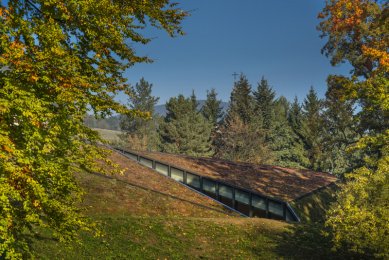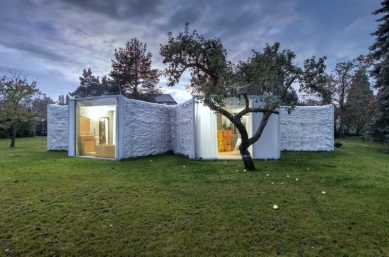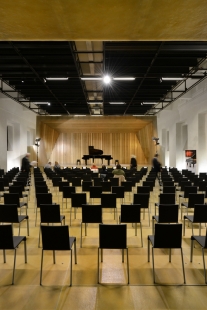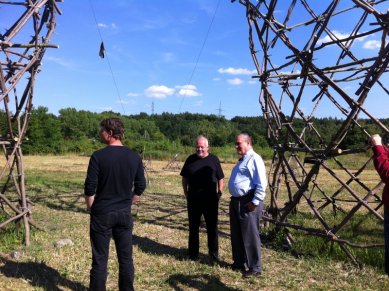
Invitation to the lecture by Petr Hájek and Martin Rajniš at ETH Zurich
Source
o.s. Kruh
o.s. Kruh
Publisher
Tisková zpráva
30.11.2014 09:00
Tisková zpráva
30.11.2014 09:00
Petr Hájek
Martin Rajniš
Petr Hájek Architekti
Huť architektury Martin Rajniš
03/12/2014 EVENT AT ETH ZURICH
Petr Hájek, Ad Triangulum + Martin Rajniš, "Martin Rajniš"
ETH Zurich, D-arch, Hönggerberg – HIL, Auditorium E 3 (Floor E, Room)
Petr Hájek *1970
He graduated from the Faculty of Architecture at the Czech Technical University in Prague and the School of Architecture at the Academy of Fine Arts in Prague. In 1998 he founded (together with Tomáš Hradečný and Jan Šépka) the architectural office HŠH architekti and later on, in 2009, his own office Petr Hájek Architekti. Among the most renowned buildings on which he participated are: adaptation of the public space at Horní Square in Olomouc, adaptation of Jiřské Square at the Prague Castle, Olomouc Archdiocesan Museum (HŠH), interventions on the Castle Hill in Olomouc (HŠH), Riding Hall – multifunctional hall in Litomyšl (HŠH), Villa in Beroun (HŠH), Villa Hermina (HŠH), Penthouse in Prague Bubeneč, Krkonošské Regional Center for Environmental Education in Vrchlabí – KCEV, Chameleon house. He has won numerous prizes for his work.
Since 2004 he has been teaching at the Faculty of Architecture at CTU in Prague, and in 2010 he was appointed an associate professor there. Since 2012 he has been running an architectural studio at the University of Fine Arts Bratislava. He is a founder and a Chairman of the Board of Art-Now, an endowment fund supporting art and talent, and a founder of LEA - Laboratory of Experimental Architecture. In 2012 he received CTU Rector’s prize for his educational activities in research of urban planning called Anastomosis.
This year he has won the Award for Sustainable Architecture in Paris, awarded by the Locus Foundation under the patronage of UNESCO. Buildings from his atelier successfully represented the Czech Republic at the International Architecture Exhibition 2010 in Venice. His work is very popular nationally as well as internationally. In many of his workshops he conducts interesting experiments with his students.
Martin Rajniš *1944
He studied architecture at the Czech Technical University and the Academy of Fine Arts in Prague. Since 2013 he has been leading the experimental studio HUŤ ARCHITEKTURY focusing on smaller projects often comprised of loosely stacked bulk timber (the so-called hollow forms). He has been nominated three times for the Mies van der Rohe Prize for his projects. He taught architecture at the Academy of Art, Architecture and Design in Prague and at the Technical University in Liberec.
Petr Hájek *1970
He graduated from the Faculty of Architecture at the Czech Technical University in Prague and the School of Architecture at the Academy of Fine Arts in Prague. In 1998, he co-founded the architectural office HŠH architekti together with Tomáš Hradečný and Jan Šépka, and in 2009, he founded his own architectural office Petr Hájek Architekti. Among the most notable buildings he has been involved in are: adaptation of Horní Square in Olomouc, adaptation of Jiřské Square at Prague Castle, Olomouc Archdiocesan Museum (HŠH), interventions on the Castle Hill in Olomouc (HŠH), Riding Hall – multifunctional hall in Litomyšl (HŠH), Villa in Beroun (HŠH), Villa Hermina (HŠH), Residential Containers, KCEV, Chameleon House. He has received numerous awards for his work (Grand Prix of the Architects Association, Freiraum no2, Bauwelt–Preis, Building of the Year, Award of the Club for Old Prague, R.Eitelberger Award, Czech nomination for the Mies van der Rohe Award.)
Since 2004, he has been teaching at the Faculty of Architecture at CTU in Prague, where he was appointed associate professor in 2010. Since 2012, he has been leading an architectural studio at the Academy of Fine Arts in Bratislava. He is the founder and chairman of the Board of the Art-Now foundation supporting art and talent, and the founder of LEA - Laboratory of Experimental Architecture. For his teaching work on urbanism research called Anastomosis, he received the Rector's Award of CTU in 2012 for the application of research into practice.
Martin Rajniš *1944
He studied architecture at the Czech Technical University and the Academy of Fine Arts in Prague. Since 2013 he has been leading the experimental studio HUŤ ARCHITEKTURY and focuses on smaller projects often composed of loosely stacked timber (the so-called hollow forms). He has been nominated three times for the prestigious Mies van der Rohe Prize for his projects. He has taught architecture at the Prague AAAD and at the Technical University in Liberec.
Petr Hájek, Ad Triangulum + Martin Rajniš, "Martin Rajniš"
ETH Zurich, D-arch, Hönggerberg – HIL, Auditorium E 3 (Floor E, Room)
Petr Hájek, Ad Triangulum
Petr Hájek will introduce three of his recently completed buildings (Riding Hall – Multifunctional Hall in Litomyšl (HŠH); Chameleon House in Prague and Krkonošské Regional Center for Environmental Education in Vrchlabí - KCEV). All of them are based on three different non-architectural principles studied by Natural Sciences: acoustics, optics and geometry. These three disciplines usually describe studied natural forces in scientific functions and laws. But natural forces may in the field of architecture acquire a different record, transcription and space …Petr Hájek *1970
He graduated from the Faculty of Architecture at the Czech Technical University in Prague and the School of Architecture at the Academy of Fine Arts in Prague. In 1998 he founded (together with Tomáš Hradečný and Jan Šépka) the architectural office HŠH architekti and later on, in 2009, his own office Petr Hájek Architekti. Among the most renowned buildings on which he participated are: adaptation of the public space at Horní Square in Olomouc, adaptation of Jiřské Square at the Prague Castle, Olomouc Archdiocesan Museum (HŠH), interventions on the Castle Hill in Olomouc (HŠH), Riding Hall – multifunctional hall in Litomyšl (HŠH), Villa in Beroun (HŠH), Villa Hermina (HŠH), Penthouse in Prague Bubeneč, Krkonošské Regional Center for Environmental Education in Vrchlabí – KCEV, Chameleon house. He has won numerous prizes for his work.
Since 2004 he has been teaching at the Faculty of Architecture at CTU in Prague, and in 2010 he was appointed an associate professor there. Since 2012 he has been running an architectural studio at the University of Fine Arts Bratislava. He is a founder and a Chairman of the Board of Art-Now, an endowment fund supporting art and talent, and a founder of LEA - Laboratory of Experimental Architecture. In 2012 he received CTU Rector’s prize for his educational activities in research of urban planning called Anastomosis.
Martin Rajniš, "Martin Rajniš"
After realizing a range of administrative, commercial and multipurpose buildings in central parts of Prague, he handed his up and running office over to his partners and set out on a journey around the world, trying to articulate a new concept of modern architecture which he called natural architecture. Together with the youngest generation of architects, he has been building experimental buildings using natural materials (wood, stone, glass), structures from nature, transitions between plan and randomness, and raw natural elements. He has been striving to return modern architecture to the shape that would be acceptable and pleasant for people and they could like it again.This year he has won the Award for Sustainable Architecture in Paris, awarded by the Locus Foundation under the patronage of UNESCO. Buildings from his atelier successfully represented the Czech Republic at the International Architecture Exhibition 2010 in Venice. His work is very popular nationally as well as internationally. In many of his workshops he conducts interesting experiments with his students.
Martin Rajniš *1944
He studied architecture at the Czech Technical University and the Academy of Fine Arts in Prague. Since 2013 he has been leading the experimental studio HUŤ ARCHITEKTURY focusing on smaller projects often comprised of loosely stacked bulk timber (the so-called hollow forms). He has been nominated three times for the Mies van der Rohe Prize for his projects. He taught architecture at the Academy of Art, Architecture and Design in Prague and at the Technical University in Liberec.
Petr Hájek, Ad Triangulum
Petr Hájek will present three recently completed buildings (Riding Hall – multifunctional hall in Litomyšl (HŠH), Chameleon House in Prague and Krkonošské Center for Environmental Education in Vrchlabí – KCEV). These buildings are based on three different non-architectural principles studied by natural sciences: acoustics, optics and geometry. These disciplines usually study natural forces through their transcription into functions and laws. But natural forces can in architecture also acquire different records, transcriptions, and different spaces…Petr Hájek *1970
He graduated from the Faculty of Architecture at the Czech Technical University in Prague and the School of Architecture at the Academy of Fine Arts in Prague. In 1998, he co-founded the architectural office HŠH architekti together with Tomáš Hradečný and Jan Šépka, and in 2009, he founded his own architectural office Petr Hájek Architekti. Among the most notable buildings he has been involved in are: adaptation of Horní Square in Olomouc, adaptation of Jiřské Square at Prague Castle, Olomouc Archdiocesan Museum (HŠH), interventions on the Castle Hill in Olomouc (HŠH), Riding Hall – multifunctional hall in Litomyšl (HŠH), Villa in Beroun (HŠH), Villa Hermina (HŠH), Residential Containers, KCEV, Chameleon House. He has received numerous awards for his work (Grand Prix of the Architects Association, Freiraum no2, Bauwelt–Preis, Building of the Year, Award of the Club for Old Prague, R.Eitelberger Award, Czech nomination for the Mies van der Rohe Award.)
Since 2004, he has been teaching at the Faculty of Architecture at CTU in Prague, where he was appointed associate professor in 2010. Since 2012, he has been leading an architectural studio at the Academy of Fine Arts in Bratislava. He is the founder and chairman of the Board of the Art-Now foundation supporting art and talent, and the founder of LEA - Laboratory of Experimental Architecture. For his teaching work on urbanism research called Anastomosis, he received the Rector's Award of CTU in 2012 for the application of research into practice.
Martin Rajniš, "Martin Rajniš"
After realizing a range of administrative, commercial, and multipurpose buildings in central parts of Prague, he handed his fully operational office over to partners and has embarked on journeys around the world in an attempt to articulate a new concept of modern architecture, which he termed natural architecture. Together with the youngest generation of architects, he is constructing experimental buildings using natural materials (wood, stone, glass), structures from nature, transitions between design and randomness, and unrefined natural elements. He seeks to return modern architecture to a form that would be acceptable, pleasant for people, and something they could once again appreciate. This year he was awarded the Sustainable Architecture Prize in Paris, awarded by the Locus Foundation under UNESCO. His atelier's buildings successfully represented the Czech Republic at the Venice Architecture Biennale in 2010. They enjoy significant national and international acclaim. In a series of workshops, he conducts interesting experiments with architecture students. His work naturally extends into urbanism, where he creates concepts for green residential landscapes, as well as into the field of design - lighting, furniture.Martin Rajniš *1944
He studied architecture at the Czech Technical University and the Academy of Fine Arts in Prague. Since 2013 he has been leading the experimental studio HUŤ ARCHITEKTURY and focuses on smaller projects often composed of loosely stacked timber (the so-called hollow forms). He has been nominated three times for the prestigious Mies van der Rohe Prize for his projects. He has taught architecture at the Prague AAAD and at the Technical University in Liberec.
The English translation is powered by AI tool. Switch to Czech to view the original text source.





0 comments
add comment
Related articles
0
22.10.2018 | Petr Hájek: Water Tower in Letná and Its Restoration
0
10.11.2014 | Invitation to the lecture by A. Gebrian, D. Krause, and M. Steinbach at ETH Zurich
0
29.10.2014 | Invitation to the lecture by Josef Pleskot and Jan Šépka at ETH Zurich
0
31.08.2014 | bread autumn 2014: Swiss-Czech inspiration










